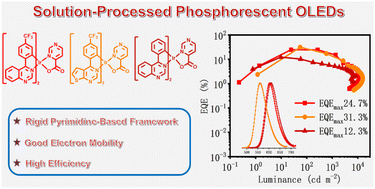Orange to red iridium(iii) complexes possessing good electron mobility with a pyrimidine-4-carboxylic acid ligand for high-performance solution-processed OLEDs with an EQE over 31%†
Abstract
Three novel iridium(III) complexes with pyrimidine carboxylic acid as the auxiliary ligand were designed, showing adjustable emission peak wavelengths from 559 nm to 610 nm with relatively high photoluminescence quantum yields (PLQYs) of 58–89% in CH2Cl2. The structures of the title complexes were confirmed by single-crystal X-ray diffraction (XRD), nuclear magnetic resonance spectroscopy (NMR), and high-resolution mass spectrometry (HRMS). Their electronic states were investigated using time-dependent density functional theory (TD-DFT) calculations. When employing these emitters to fabricate solution-processed organic light-emitting diodes (OLEDs), the obtained orange and red OLEDs exhibit prominent performances with the maximum current efficiencies of 95.4 cd A−1 and 39.8 cd A−1, and the maximum external quantum efficiencies (EQEmax) of 31.3% and 24.7%, both of which are ranked among the highest values for orange and red solution-processed OLEDs.



 Please wait while we load your content...
Please wait while we load your content...